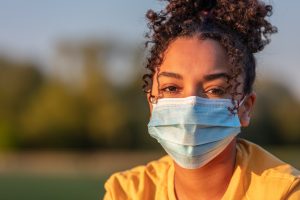Published on April 21, 2022
Video Friday: Roger Seheult, MD of MedCram presents the case for sunlight as a treatment for COVID-19
Key Points
- Many studies have shown a lower risk of COVID-19 infection, severity, and death with higher vitamin D levels, which are associated with increased exposure to UVB from sunlight
- Exposure to sunshine has many health benefits beyond vitamin D production, including the production of important anti-inflammatory and antioxidant chemicals, such as the master antioxidant melatonin, which is a major antioxidant that protects the mitochondria from oxidative stress
- Increased UVA exposure has also been associated with lower COVID deaths, indicating that there are additional benefits from sun exposure for COVID beyond just vitamin D, and that a simple supplement cannot replace all the benefits of sunshine!
 Infection with the SARS-CoV-2 virus induces a pronounced inflammatory response within the body, with key characteristics of COVID-19 disease being high levels of inflammation and oxidative stress. Certain antioxidant and anti-inflammatory responses that are necessary in order to prevent damage caused by inflammation and oxidative stress are down-regulated during COVID-19, and this is hypothesized to be a principle cause of multiple organ failure and death due to the disease.
Infection with the SARS-CoV-2 virus induces a pronounced inflammatory response within the body, with key characteristics of COVID-19 disease being high levels of inflammation and oxidative stress. Certain antioxidant and anti-inflammatory responses that are necessary in order to prevent damage caused by inflammation and oxidative stress are down-regulated during COVID-19, and this is hypothesized to be a principle cause of multiple organ failure and death due to the disease.
Exposure to sunshine has many health benefits beyond vitamin D production, including the production of important anti-inflammatory and antioxidant chemicals, such as the master antioxidant melatonin. In the video featured below, Roger Seheult, MD of MedCram presents the case for sunlight as a treatment for COVID-19.
Watch the Video
After watching the video, be sure to take note of the details below.
COVID-19 and Vitamin D
Respiratory viral infections peak during the winter (such as the flu), just as hospitalizations due to COVID-19 correlate to length of day (winter vs summer); trends also indicate that the higher latitude of a country, the earlier the surge date for COVID-19
A study by Kaufman et al. looked at vitamin D levels over a year and COVID-19 test results, with data from over 190,000 patients in 50 US states. The investigators used zip code data to match with US Census data to perform analyses based on race/ethnicity and latitude, and found a 53% lower COVID-19 positivity rate with higher vitamin D levels
Many other studies have shown a lower risk of COVID-19 infection, severity, and death with higher vitamin D levels including a new RCT which found that participants taking vitamin D had a 77% reduced risk of SARS-CoV-2 infection compared to those taking a placebo
Unfortunately, the example Dr. Seheult showed in the video using a single large dose of vitamin D to demonstrate the possible ineffectiveness of vitamin D against COVID-19 is an example of a poorly designed study, as single large bolus doses often do not show positive results and are more likely to have negative results
Additional Benefits from Sunshine
The sun produces many different wavelengths of energy, each with different effects on the body
Near infrared light (NIR) provides warmth and penetrates through epidermis and deep into sub cutaneous tissues and mitochondria of cells
Oxidative stress can cause damage to mitochondria, which can lead to inflammation and disease
Near infrared from sunlight activates the production of melatonin, which is a major antioxidant that protects the mitochondria from oxidative stress
Not enough sunlight and not enough sleep can lead to less melatonin production and increased oxidative stress and disease
Studies have found much higher levels of oxidative stress and damage due to oxidative stress among COVID-19 patients
Increased UVA exposure has been associated with lower COVID deaths, indicating that there are additional benefits from sun exposure for COVID beyond just vitamin D
There is a long history of using the sun and sun beds for health
Natural light exposure from sunshine and fire (with a combination of NIR and UV light) produce vitamin D and melatonin, both health-promoting elements; this is compared to modern society (with a lack of NIR and UV light, and increased oxidative stress and decreased melatonin) which promotes disease
Dr. Seheult’s Call to Action:
- More well-controlled RCTs, more time outside for everyone!
- Do not need to be in direct sunlight to get NIR (can still cover up to get NIR but not UV)
- Consider having patients outside
- Oral melatonin and vitamin D are not substitutes for sunshine!
- The full benefits of the sun cannot be replaced by taking a supplement
Vitamin D is Only One of the Many Health Benefits of Sunshine Exposure
The vitamin D level is often used as a measurement for sun exposure, and especially for those who don’t supplement with vitamin D, a vitamin D deficiency can also indicate “sunshine deficiency.” It is important to remember, however, that sunshine has many health benefits beyond vitamin D production. Exposure to the sun helps the body produce other important chemicals and nutrients, such as nitric oxide and melatonin. Sunshine exposure also results in the production of serotonin and beta-endorphins, which promote mood enhancement and relaxation, relieve pain, and boost immunity. Proper sun exposure is a must, with the most important rule being “don’t burn!”
Supplements Do Not Replace Sunlight
Taking a vitamin D supplement cannot replace all the benefits of a lifestyle that incorporates regular sunshine exposure. Learn more this May (next month!) during our 6th annual Sunshine Month event!
Are You Suffering from Sunshine Deficiency and Resulting Low Vitamin D?
 Having and maintaining healthy vitamin D levels and other nutrient levels can help improve your health now and for your future. Choose which additional nutrients to measure, such as your omega-3s and essential minerals including magnesium and zinc, by creating your custom home test kit today. Take steps to improve the status of each of these measurements to benefit your overall health. With measurement you can then determine how much is needed and steps to achieve your goals. You can also track your own intakes, symptoms and results to see what works best for YOU.
Having and maintaining healthy vitamin D levels and other nutrient levels can help improve your health now and for your future. Choose which additional nutrients to measure, such as your omega-3s and essential minerals including magnesium and zinc, by creating your custom home test kit today. Take steps to improve the status of each of these measurements to benefit your overall health. With measurement you can then determine how much is needed and steps to achieve your goals. You can also track your own intakes, symptoms and results to see what works best for YOU.
Enroll in D*action and Test Your Levels Today!





